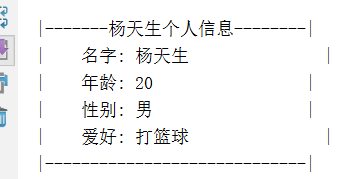练习:用户输入姓名、年龄、工作、爱好 ,然后打印成以下格式 ------------ info of Egon ----------- Name : Egon Age : 22 Sex : male Job : Teacher ------------- end -----------------
name=input('请输入用户名: ')
age=input('请输入年龄: ')
sex=input('请输入性别: ')
aihao=input('请输入爱好: ')
a='''
|-------杨天生个人信息--------|
| 名字: %s |
| 年龄: %s |
| 性别: %s |
| 爱好: %s |
|-----------------------------|
'''%(name,age,sex,aihao)
print(a)
运行的结果


-----------------------
------------------------------列表
a = '''
aaaaaaa
aaaaaaa
bbbbbbbbbb
bbbbbbbbb
'''
print(a)
name = 'aaa'
aaa='17'
name+aaa
a=[['yts',20], ['aihao']]
print(a[1])
--------------------------------------字典
aaa=[
{'name':'yts','nianling':['20','22'],'aihao':['篮球','旅游']},
{'name': 'wjy', 'nianling':18, 'aihao': ['看书','旅游']},
{'name': 'yct', 'nianling':20, 'aihao': ['游戏','台球']},
]
print(aaa[0]['nianling'][0]) #取第1列的年龄第1个
print(aaa[1]['aihao'][1]) #取第二列的爱好第二个 #在python中数字排序都是从0开始的 所以0代表第一位
print(aaa[1]['name']) #取第二列的 姓名
b={
'姓名':'杨天生',
'爱好':['篮球','台球'],
'公司信息':{
'公司名称':'淘宝',
'类型':'购物',
'号码':['110','120'],
}
}
print(b['name'])
print(b['公司信息']['公司名称']) #取公司名称
print(b['公司信息']['号码'][1]) #取公司第几个号码
print(b['爱好'][1]) 取爱好第几个
------------------------------------------------------
------------------------------------布尔
true=真 false=假
a=3
b=5
print(a > b) #-----False 假
print(a < b) #----True 真
if a > b
print(a is bigger than b )
else
print(a is smaller than b )
1.可变类型:在id不变的情况下,value可以变,则称为可变类型,如列表,字典
2. 不可变类型:value一旦改变,id也改变,则称为不可变类型(id变,意味着创建了新的内存空间)
-------------------------------------------------------
-------------------------格式化输出
print('姓名:%s, 年龄:%d ' %('yts',11)), # --------%s字符串占位符:可以接收字符串,也可接收数字
----------------%d数字占位符:只能接收数字
@age=input('your age: ')
print('My name is %s,my age is %s' %(name,age))
print('My name is %s,my age is %d' %(name,age)) #----用户输入18,会存成字符串18,无法传给%d #age为字符串类型,无法传给%d,所以会报错
#---------------流程控制if....else
既然我们编程的目的是为了控制计算机能够像人脑一样工作,那么人脑能做什么,就需要程序中有相应的机制去模拟。人脑无非是数学运算和逻辑运算,对于数学运算在上一节我们已经说过了。对于逻辑运算,即人根据外部条件的变化而做出不同的反映,比如
1 如果:女人的年龄>30岁,那么:叫阿姨
age_of_girl=31
if age_of_girl > 30:
print('阿姨好')
2 如果:女人的年龄>30岁,那么:叫阿姨,否则:叫小姐
age_of_girl=18
if age_of_girl > 30:
print('阿姨好')
else:
print('小姐好')
3 如果:女人的年龄>=18并且<22岁并且身高>170并且体重<100并且是漂亮的,那么:表白,否则:叫阿姨
age_of_girl=18
height=171
weight=99
is_pretty=True
if age_of_girl >= 18 and age_of_girl < 22 and height > 170 and weight < 100 and is_pretty == True:
print('表白...')else:
print('阿姨好')
如果:成绩>=90,那么:优秀
如果成绩>=80且<90,那么:良好
如果成绩>=70且<80,那么:普通
其他情况:很差
a=input('请输入你的成绩: ')
a=int(a)
if a >= 90:
print('优秀')
elif a >= 80:
print('良好')
elif a >= 70:
print('一般')
else:
print('不及格')
if 条件1: 缩进的代码块 elif 条件2: 缩进的代码块 elif 条件3: 缩进的代码块 ...... else: 缩进的代码块
-----------
简单的输入用户名
#!/usr/bin/env python
# -*- coding: utf-8 -*-
name=input('请输入用户名: ')
password=input('请输入密码: ')
if name == 'yts' and password == '123':
print('输入正确')
else:
print('输入的用户名和密码都不正确baye')
--------------------------
根据用户输入内容输出其权限
'''
yts ------>CEO
test ------>CTO
tom ,nick------->CKO
其他 ------->员工
'''
name=input('请输入用户名字: ')
if name == 'yts':
print('CEO')
elif name == 'test':
print('CTO')
elif name == 'tom' or name == 'nick':
print('CKO')
else:
print('员工')
-----------------------
# 如果:今天是Monday,那么:上班
# 如果:今天是Tuesday,那么:上班
# 如果:今天是Wednesday,那么:上班
# 如果:今天是Thursday,那么:上班
# 如果:今天是Friday,那么:上班
# 如果:今天是Saturday,那么:出去浪
# 如果:今天是Sunday,那么:出去浪
#方式一:
today=input('>>: ')
if today == 'Monday':
print('上班')
elif today == 'Tuesday':
print('上班')
elif today == 'Wednesday':
print('上班')
elif today == 'Thursday':
print('上班')
elif today == 'Friday':
print('上班')
elif today == 'Saturday':
print('出去浪')
elif today == 'Sunday':
print('出去浪')
else:
print('''必须输入其中一种:
Monday
Tuesday
Wednesday
Thursday
Friday
Saturday
Sunday
''')
#方式二:
today=input('>>: ')
if today == 'Saturday' or today == 'Sunday':
print('出去浪')
elif today == 'Monday' or today == 'Tuesday' or today == 'Wednesday' \
or today == 'Thursday' or today == 'Friday':
print('上班')
else:
print('''必须输入其中一种:
Monday
Tuesday
Wednesday
Thursday
Friday
Saturday
Sunday
''')
#方式三:
today=input('>>: ')
if today in ['Saturday','Sunday']:
print('出去浪')
elif today in ['Monday','Tuesday','Wednesday','Thursday','Friday']:
print('上班')
else:
print('''必须输入其中一种:
Monday
Tuesday
Wednesday
Thursday
Friday
Saturday
Sunday
''')
-----------------------
流程控制之while循环
为何要用循环语句
#上节课我们已经学会用if .. else 来猜年龄的游戏啦,但是只能猜一次就中的机率太小了,如果我想给玩家3次机会呢?就是程序启动后,玩家最多可以试3次,这个怎么弄呢?你总不会想着把代码复制3次吧。。。。

#在表白的基础上继续:
#如果表白成功,那么:在一起
#否则:打印。。。
age_of_girl=18
height=171
weight=99
is_pretty=True
success=False
if age_of_girl >= 18 and age_of_girl < 22 and height > 170 and weight < 100 and is_pretty == True:
if success:
print('表白成功,在一起')
else:
print('什么爱情不爱情的,爱nmlgb的爱情,爱nmlg啊...')
else:
print('阿姨好')




